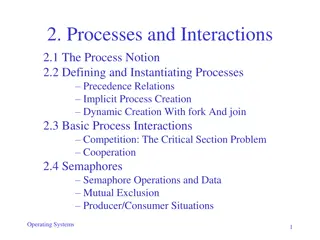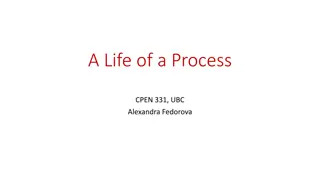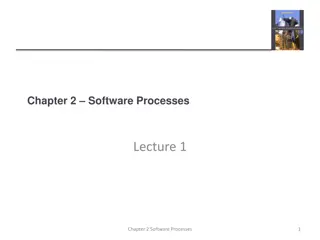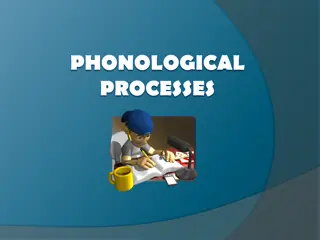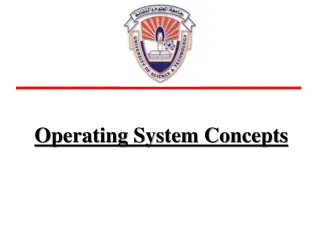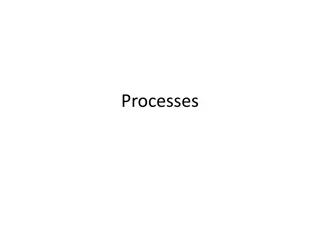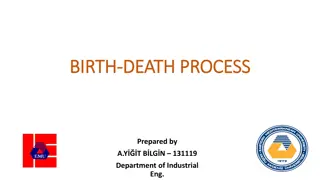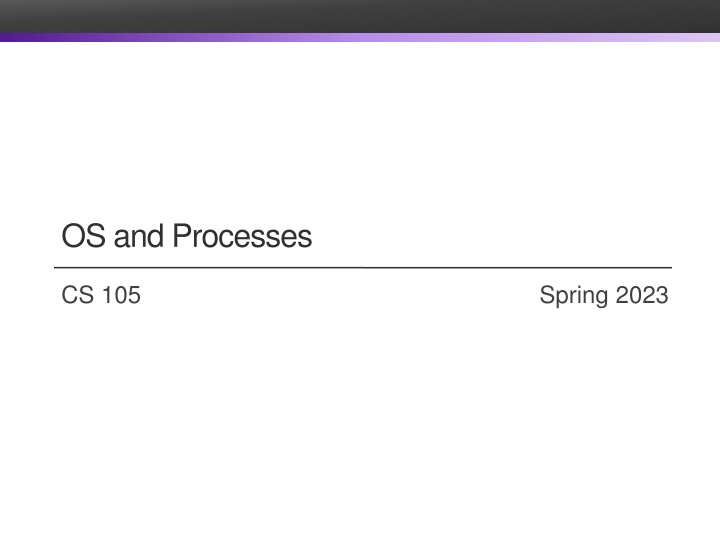
Operating Systems and Processes: Fundamentals and Examples
Explore the basics of operating systems, processes, and their functionalities. Learn about resource management, process hierarchy, process creation, and execution examples like fork and execve. Discover key concepts in OSCS 105 Spring 2023.
Download Presentation

Please find below an Image/Link to download the presentation.
The content on the website is provided AS IS for your information and personal use only. It may not be sold, licensed, or shared on other websites without obtaining consent from the author. If you encounter any issues during the download, it is possible that the publisher has removed the file from their server.
You are allowed to download the files provided on this website for personal or commercial use, subject to the condition that they are used lawfully. All files are the property of their respective owners.
The content on the website is provided AS IS for your information and personal use only. It may not be sold, licensed, or shared on other websites without obtaining consent from the author.
E N D
Presentation Transcript
OS and Processes CS 105 Spring 2023
Intro to Operating Systems the operating system is a piece of software that manages a computer's resources for its users and their applications Examples: OSX, Windows, Ubuntu, iOS, Android, Chrome OS resource allocation isolation communication access control multiprocessing virtual memory reliable networking virtual machines user interface file I/O device management process control OS is divided into two pieces: user-mode and kernel-mode core OS functionality is implemented by the OS kernel
Processes A program is a file containing code + data that describes a computation A process is an instance of a running program. One of the most profound ideas in computer science Not the same as program or processor Memory Stack Heap Data Code CPU Registers
Linux Process Hierarchy [0] init [1] Daemon e.g. httpd Login shell Login shell Child Child Child Note: you can view the hierarchy using the Linux pstree command Grandchild Grandchild
Creating Processes Parent process creates a new running child process by calling fork int fork(void) Returns 0 to the child process, child s PID to parent process Child is almost identical to parent: Child get an identical (but separate) copy of the parent s virtual address space. Child gets identical copies of the parent s open file descriptors Child has a different PID than the parent fork is interesting (and often confusing) because it is called oncebut returns twice
fork Example Call once, return twice int main(){ Duplicate but separate address space x has a value of 1 when fork returns in parent and child Subsequent changes to x are independent pid_t pid; int x = 1; pid = fork(); if (pid == 0) { /* Child */ printf("child : x=%d\n", ++x); return 0; } /* Parent */ printf("parent: x=%d\n", --x); return 0; } Shared open files stdout is the same in both parent and child x=2 2 printf x=0 0 Child x=1 Parent main fork printf
execve: Loading and Running Programs int execve(char *filename, char *argv[], char *envp[]) Loads and runs in the current process: Executable file filename Can be object file or script file beginning with #!interpreter (e.g., #!/bin/bash) with argument list argv By convention argv[0]==filename and environment variable list envp name=value strings (e.g., USER=droh) getenv, putenv, printenv Overwrites code, data, and stack Retains PID, open files and signal context Called once and never returns except if there is an error
Multiprocessing Computer runs many processes simultaneously Running program top on Mac Identified by Process ID (PID)
Multiprocessing: The Illusion Memory Memory Memory Stack Heap Data Stack Heap Data Stack Heap Data Code Code Code CPU CPU CPU Registers Registers Registers Process provides each program with two key abstractions: Logical control flow Each program seems to have exclusive use of the CPU Provided by kernel mechanism called context switching Private address space Each program seems to have exclusive use of main memory. Provided by kernel mechanism called virtual memory
Multiprocessing: The (Traditional) Reality Memory Stack Heap Data Stack Heap Data Stack Heap Data Code Saved registers Code Saved registers Code Saved registers CPU Registers Single processor executes multiple processes concurrently Process executions interleaved (multitasking) Register values for nonexecuting processes saved in memory Address spaces managed by virtual memory system
Context Switching Processes are managed by a shared chunk of memory- resident kernel code Important: the kernel code is not a separate process, but rather code and data structures that the OS uses to manage all processes Control flow passes from one process to another via a context switch Process A Process B user code context switch kernel code Time user code context switch kernel code user code
Process Control Block (PCB) To implement a context switch, OS maintains a PCB for each process containing: process table, which contains information about the process (id, user, privilege level, arguments, status) location of executable on disk file table register values (general-purpose registers, float registers, pc, eflags ) memory state scheduling information ... and more!
Multiprocessing: The (Traditional) Reality Memory Stack Heap Data Stack Heap Data Stack Heap Data Code Saved registers Code Saved registers Code Saved registers CPU Registers 1. Save current registers to memory (in PCB)
Multiprocessing: The (Traditional) Reality Memory Stack Heap Data Stack Heap Data Stack Heap Data Code Saved registers Code Saved registers Code Saved registers CPU Registers 1. Save current registers to memory (in PCB) 2. Schedule next process for execution
Multiprocessing: The (Traditional) Reality Memory Stack Heap Data Stack Heap Data Stack Heap Data Code Saved registers Code Saved registers Code Saved registers CPU Registers 1. Save current registers to memory (in PCB) 2. Schedule next process for execution 3. Load saved registers and switch address space
Multiprocessing: The (Modern) Reality Memory Stack Heap Data Stack Heap Data Stack Heap Data Code Saved registers Code Saved registers Code Saved registers CPU CPU Registers Registers Multicore processors Multiple CPUs on single chip Share main memory (and some of the caches) Each can execute a separate process Scheduling of processors onto cores done by kernel
Exercise: Context Switching A hardware designer argues that there are now enough on- chip transistors to build a CPU with 1024 integer registers and 512 floating point registers. As a result, the compiler should almost never need to store anything on the stack. As a new operating systems expert, would you recommend building this new design.
Process Life Cycle Init fork Runnable Running scheduled
Exceptions An exception is a transfer of control to the OS kernel in response to some event (i.e., change in processor state) Kernel is the memory-resident part of the OS User code Kernel code Exception Event I_current I_next Exception processing by exception handler Return to I_current Return to I_next Abort
Exception Tables Each type of event has a unique exception number k Exception numbers Code for exception handler 0 k = index into exception table (a.k.a. interrupt vector) Exception Table Code for exception handler 1 0 1 2 Handler k is called each time exception k occurs Code for exception handler 2 ... n-1 ... Code for exception handler n-1
Synchronous Exceptions Caused by events that occur as a result of executing an instruction: Traps Intentional Examples: system calls, breakpoint traps, special instructions Returns control to next instruction Faults Unintentional but possibly recoverable Examples: page faults (recoverable), protection faults (unrecoverable), floating point exceptions Either re-executes faulting ( current ) instruction or aborts Aborts Unintentional and unrecoverable Examples: illegal instruction, divide-by-zero, parity error, machine check Aborts current program
Interrupts (Asynchronous Exceptions) Caused by events external to the process Indicated by setting the processor s interrupt pin Handler returns to next instruction Examples: Timer interrupt Every few ms, an external timer chip triggers an interrupt Used by the kernel to take back control from user programs I/O interrupt from external device Hitting Ctrl-C at the keyboard Arrival of a packet from a network Arrival of data from a disk
Process Life Cycle Init interrupt, yield fork Runnable Running scheduled
fork Example int main(){ Call once, return twice Duplicate but separate address space x has a value of 1 when fork returns in parent and child Subsequent changes to x are independent pid_t pid; int x = 1; pid = Fork(); if (pid == 0) { /* Child */ printf("child : x=%d\n", ++x); return 0; } /* Parent */ printf("parent: x=%d\n", --x); return 0; } Shared open files stdout is the same in both parent and child x=2 2 printf x=0 0 Concurrent execution Can t predict execution order of parent and child Child x=1 Parent main fork printf Exercise: What are all the possible outputs of this program?
Modeling fork with Process Graphs A process graphis a useful tool for capturing the partial ordering of statements in a concurrent program: Each vertex is the execution of a statement a -> b means a happens before b Edges can be labeled with current value of variables printf vertices can be labeled with output Each graph begins with a vertex with no inedges Any topological sort of the graph corresponds to a feasible total ordering. Total ordering of vertices where all edges point from left to right
Interpreting Process Graphs Original graph: x=2 2 printf x=0 0 Child x=1 Parent main fork printf Feasible total ordering: Relabeled graph: e a b e c a b c Infeasible total ordering: a e b c
fork Example: Two consecutive forks Bye printf Bye void fork1() { printf("L0\n"); fork(); printf("L1\n"); fork(); printf("Bye\n"); } L1 printf fork printf Bye printf Bye L1 L0 printf fork printf printf fork L0 L1 Bye Bye L1 Bye Bye L0 Bye L1 Bye L1 Bye Bye Which of these outputs are feasible?
Exercise: Forks and Feasible Schedules For each of the following programs, draw the process graph and then determine which of the possible outputs are feasible void fork2(){ printf("L0\n"); if (fork() != 0) { printf("L1\n"); if (fork() != 0) { printf("L2\n"); void fork3(){ printf("L0\n"); if (fork() == 0) { printf("L1\n"); if (fork() == 0) { printf("L2\n"); } } printf("Bye\n"); } } } printf("Bye\n"); } L0 L1 Bye Bye L2 Bye L0 Bye L1 Bye Bye L2 L0 Bye L1 Bye Bye L2 L0 Bye L1 L2 Bye Bye
Process Life Cycle Init Terminated interrupt, yield fork Runnable Running scheduled process or I/O completion wait, I/O operation Stopped
Reaping Children Reaping Performed by parent on terminated child (using wait or waitpid) Parent is given exit status information Kernel then deletes zombie child process int wait(int *child_status) Suspends current process until one of its children terminates Return value is the pid of the child process that terminated If child_status!= NULL, then the integer it points to will be set to a value that indicates reason the child terminated and the exit status: Checked using macros defined in wait.h WIFEXITED, WEXITSTATIS, WIFSIGNALED, WTERMSIG, WIFSTOPPED, WSTOPSIG, WIFCONTINUED See textbook for details
wait Example void fork6() { int child_status; HC exit printf if (fork() == 0) { printf("HC: hello from child\n"); exit(0); } else { printf("HP: hello from parent\n"); wait(&child_status); printf("CT: child has terminated\n"); } printf("Bye\n"); } CT Bye HP printf wait printf fork Feasible output: HC HP CT Bye Infeasible output: HP CT Bye HC
Reaping Children What if parent doesn t reap? If any parent terminates without reaping a child, then the orphaned child will be reaped by init process (pid == 1) So, only need explicit reaping in long-running processes e.g., shells and servers
Process Life Cycle Init Terminated interrupt, yield fork return from main, exit, terminated Runnable Running scheduled process or I/O completion wait, I/O operation Stopped
Terminating Processes Process becomes terminated for one of three reasons: Returning from the main routine Calling the exit function Receiving a signal whose default action is to terminate void exit(int status) Terminates with an exit status of status Convention: normal return status is 0, nonzero on error Another way to explicitly set the exit status is to return an integer value from the main routine exit is called once but never returns.

